“When the pandemic first broke, we were able to pivot, keep the kids tuned in, and give them a sense of community and belonging,” said Michael A. Molina, director of Fordham’s STEP program. “I think that was extremely important and part of why we received this award.”
STEP is a state-funded program that helps minority and economically disadvantaged junior high and high school students prepare for professions in areas where they are underrepresented, especially STEM. Fordham spearheads two STEP programs—one at Rose Hill, the other at Lincoln Center—that collectively serve more than 500 students every year.
In typical years, STEP students receive academic counseling, internships, scholarships, and research opportunities both on and off campus. In addition to regular programming after school and during the summer, they have conducted research with professors at the Rose Hill campus and presented their findings alongside Fordham students at research symposiums. During the pandemic, they continued to learn and stay connected through reimagined ways of learning. In a virtual winter panel, successful Fordham alumni offered advice to STEP students. Last summer, a Fordham professor helped STEP students make connections between the civil rights movement and the Black Lives Matter movement; a University psychologist also offered guidance on how to understand racial trauma and identify strategies for self-care.
This fall, more STEP graduates than ever will be entering Fordham as first-year college students, said Molina.
“This is the largest contingent we’ve had since 1986, when we first started the program at Rose Hill,” said Molina, adding that the usual cohort is about five students, but this year, the number is 18. “And this is not an accident—this is something we’ve been working on for a long time. For the past five to 10 years, our team and the admissions office have been emphasizing to the STEP kids to consider coming to Fordham and joining CSTEP so we can continue to support them.”
CSTEP is similar to STEP, but the C stands for “collegiate.” The state program prepares undergraduate scholars from underrepresented groups for careers in STEM, health, and licensed fields. Fordham’s program is one of the largest in the state. This fall, Fordham CSTEP will resume in-person programming because students on campus are required to be vaccinated. But the STEP program, which serves local junior and high school students, will stay virtual until vaccinations are available and mandated for all children, said Molina.
“We’re going to continue doing what we’ve been doing: create a program that’s as interactive as possible with less lecturing and more of a hands-on approach with projects and faculty,” Molina said. “I’m optimistic. We have a lot of partners, great staff, and teachers who are creative.”
In a few weeks, Molina and his team will welcome to campus not only first-year students, but CSTEP sophomores who never stepped foot on campus during the pandemic when they were first-year students themselves. The CSTEP students, who served as virtual mentors to STEP students during the pandemic, will continue in that role, said Molina.
“One of the biggest things we’ll be focused on is building community with the kids. In-person relationship-building, the academic and non-academic relationships that students build with each other and us—all of that, we’re going to need to rebuild with the kids,” Molina said, referring both to STEP and CSTEP students. “We’re looking forward to having them back.”
]]>“I’m meeting people who I would have never been able to meet in other ways from both campuses, and I’m watching the things that I see every day coming to life in a virtual world,” said Zoe Demacopoulos, a senior at Fordham College at Lincoln Center who helped build the virtual entrance of Lowenstein Center. “It’s nice to know that I can still build community and hang out with people on a semi-regular basis [during the pandemic].”
The goal of the project is to engage students, especially the first-year class, during a year that has made social activity more difficult than usual, said Patricia Peek, Ph.D., dean of undergraduate admission.
A Way to Connect
“When we learned last summer that other colleges had these fun images, we thought that it might be a great way to create a virtual Fordham while giving new students a way to engage with each other in a virtual space,” Peek said.
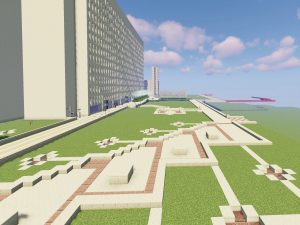
After months of planning, RamCraft began in earnest this spring. The project is a collaborative effort among student volunteers and the Department of Communication and Media Studies, with the support of Fordham IT, Peter A. Stace, Ph.D., senior vice president for enrollment and strategy, and Eva Badowska, Ph.D., dean of the faculty of arts and sciences and associate vice president for arts and sciences.
On Wednesday evenings, the student design team logs onto Minecraft and works on Fordham’s virtual Lincoln Center campus. (Design of the Rose Hill campus will begin this summer.) They communicate through Discord, a free chat service that is popular among gaming communities, where they can hear each other’s voices and watch each other stack virtual blocks in real time.
The underlying purpose of these meetings is to create an inclusive, supportive community where students can connect through a fun activity and escape from the stress of the pandemic, said the faculty project manager, Christopher Vicari.
“I’ll throw on lo-fi hip-hop beats. We’ll vibe, chill, and just build and talk,” said Vicari, an educational technologist in the communication and media studies department.
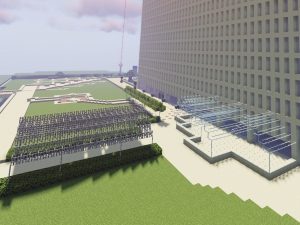
There are 10 to 15 students working on RamCraft, ranging from beginners to longtime players who were introduced to the game when they were children. Among them is Demacopoulos, a senior at Fordham College at Lincoln Center who plans to start at the Graduate School of Education in the fall on the 5-year track. The aspiring high school English teacher has played Minecraft since the game was released in 2011. It used to be a fun way for her, as a New York resident, to bond with her long-distance childhood best friend from Massachusetts for nearly seven years. Now the game is serving a new purpose.
Demacopoulos and her classmates have been “building” since March, selecting block styles and ratios based on blueprints from Fordham Facilities Management, images from Google Earth, and photos of campus shot on their smartphones, said Vicari.
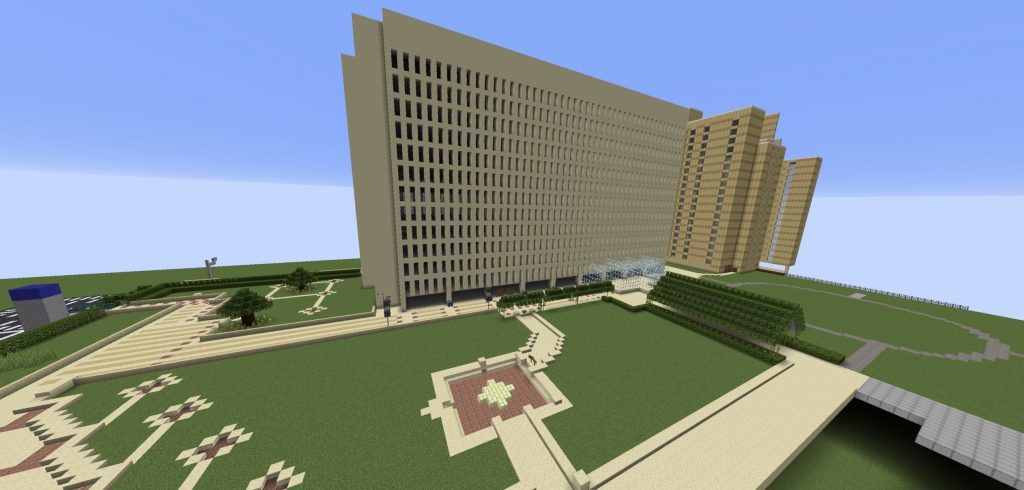
Striving for Precision
“Some students have gone to campus to take pictures of different elements of the architecture and floor patterns so we know how to match it as one-to-one as possible,” said Vicari, who has also visited campus to take photos. “Our goal is to be a little OCD and to try and get it as accurately as we can. But that’s where we’ll most likely have the most fun, too, because we get to flavor things individually.”
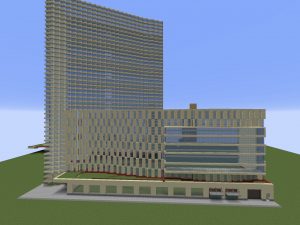
The RamCraft team has finished building the exterior of the Lowenstein Center, McMahon Hall, and Columbus Avenue. Next up are McKeon Hall and the Law School.
The team is deliberating on how far away the virtual Lincoln Center campus should be from the Rose Hill campus. They have yet to complete the most difficult tasks—the interiors of each building, including the Lowenstein lobby. The overall project won’t be finished for at least two more years, Vicari estimated. But so far, the project has accomplished something more poignant during a difficult year.
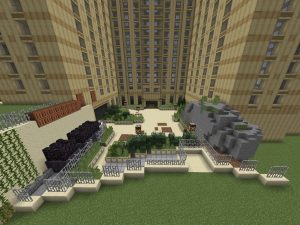
“One of the big issues of the pandemic was finding a social circle or a group of friends in a university,” said Preeti Grewal, a first-year student at Fordham College at Lincoln Center who is studying remotely from Queens. “You’re starting off in a brand new place, and you don’t really know anyone. But I’ve been able to play Minecraft, study, and manage to make friends.”
At the end of her four years at Fordham, Grewal will also have a special project in her portfolio.
“There were a lot of murals in my old high school. All the names would be on the bottom left with ‘Class of 1993’ or something,” said Grewal, a political science student on the pre-law track. “That’s going to be us, but on Minecraft.”
Students interested in participating in RamCraft can contact Vicari at [email protected].
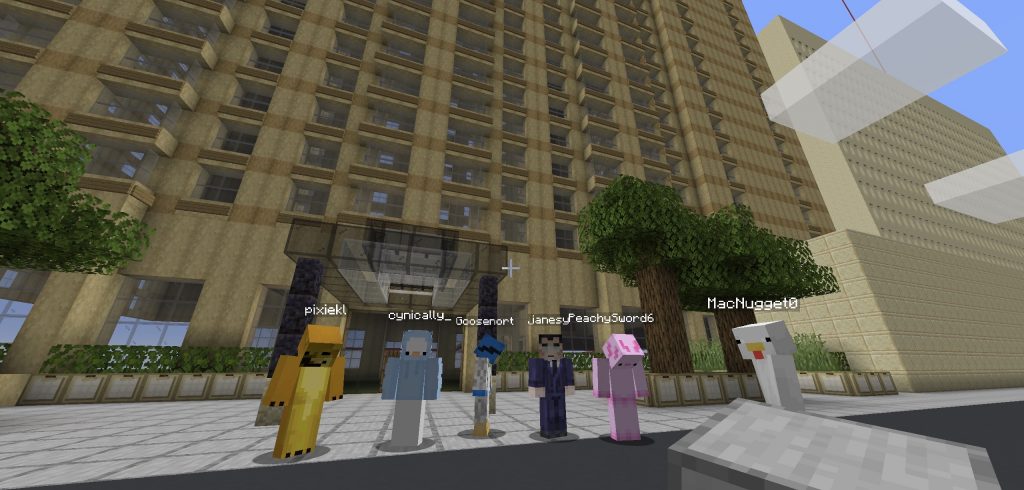
On March 16, Fordham received a helping hand from the State of New York, which awarded the University a $5 million matching capital grant from the Higher Education Capital Match Program (HECap).
The grant, which is administered by the Dormitory Authority of the State of New York (DASNY), will pay for construction of the glass-covered arcade, or passageway, that will connect the new 71,000-square-foot, four-level addition to a renovated McGinley Center, the Rose Hill Gym, and the Lombardi Center. The addition is set to open this fall.
A Partnership with State Government
For every dollar in state matching funds, private, not-for-profit colleges and universities in New York must provide $3 in support of their projects. The projected timeline of the campus center’s Phase II renovation is expected to be 14 months.
Fordham was one of 35 colleges and universities to receive the grant this year. Lesley Massiah-Arthur, associate vice president and special assistant to the president for government relations, whose office secured the grant, said she was thrilled that Fordham received the maximum amount possible. A major part of the application process centered around demonstrating that the project will generate jobs and benefit the community at large, she said.
“What this investment allows us to do is not only expand the University’s resources for our students but to expand community access to the University,” she said, noting that Fordham allows community nonprofits to hold meetings on campus, free of charge.
Contributing to the Economy
At $5 million, the grant is the largest in a series of grants totaling $14.75 million that Fordham has secured from the state over the last five years. Last year, a $2.5 million State and Municipal Facilities Grant was awarded for lab renovations at John Mulcahy Hall. In 2018, the University received a $3.75 million HECap grant for a steam boiler replacement in Thebaud Hall. And in 2019, Massiah-Arthur’s office secured a $1 million HECap grant for renovating the façade and creating an open green space at Lincoln Center.
Massiah-Arthur said the funds showed that leaders in Albany appreciate the value that private colleges and universities bring to the state’s economy. According to a 2017 report by the Commission on Independent Colleges and Universities, Fordham’s total economic impact on the New York City region is $1.5 billion.
The project will also generate approximately 250 union jobs, ranging from laborers to engineers, over the course of the contract.
“The fact that independent universities have a capital program [HECap] that’s specific to us demonstrates that our capital construction is very important, especially when you consider that as a sector, our institutions contribute about $88 billion to the New York state economy,” she said.
“This just goes to show that a partnership between the state and our sector can be a benefit not just for the institution but the state, the regions, and communities we’re in.”
Joseph M. McShane, S.J., president of Fordham, who recently served as chair of the Commission on Independent Colleges and Universities, said he was gratified that New York’s leaders see institutions like Fordham as partners worthy of support.
“The new center will be at the heart of the campus experience and therefore at the heart of the University’s mission,” Father McShane said.
“It will bring together all students, faculty, and staff under one roof, in a space that maximizes opportunities for shared meals, shared learning, and shared recreation. We are grateful that the Dormitory Authority recognized both Fordham’s need and our contribution to the state’s intellectual, cultural, and financial health.”
A Unique, Light-Filled Space
The arcade and the new entrance to the center promise to be the most dramatic of all the elements of the new campus center. Marco Valera, vice president for administration, said that the only other building that currently features a large indoor space bathed in natural light from above is the Platt Court atrium at the Lincoln Center Campus.
In addition to joining the original McGinley Center with the addition, the new arcade will stretch to the east and north to envelop the space separating those two buildings from the Rose Hill Gym and the Lombardi Center.
It is also arguably the trickiest part of the construction, Valera said, as it requires demolition, rehabilitation, and construction in close proximity to spaces that will continue to be occupied.
“The uniqueness of this particular space is that it joins the new building with the old stonework of the gym, so you’ve got a little flavor of the kind of gallery at the Metropolitan Museum of Art where they join old buildings to new buildings,” he said.
]]>
Less obvious than its expression of Fordham’s Catholic identity, however, is the fact that for one stone carver, it is the ultimate expression of his artistic passions.
“It’s a talent God gave me,” said Michael Orekunrin, who carved the cross from a 2,600-pound block of limestone for the Mount Vernon-based Petrillo Stone Corporation. The recently completed sculpture will be installed in January.
“I’ve always loved anything art. I always wanted to create things that are unique. Even when I was young, I loved to create things, and people told my parents, ‘He’s meant to go to the United States or England to study art because he has this special talent for creativity.’”
From Nigeria to the Bronx
Orekunrin moved to the United States shortly after graduating from Obafemi Awolowo University in his native Nigeria. In 1994, the Petrillo corporation sponsored him for a green card, and seven years later, he became an American citizen. He has since married, had two children, and earned an M.F.A. in sculpture from Lehman College. During his years working as a master carver/cutter for Petrillo, Orekunrin worked on spaces as varied as the N.B.A store on Fifth Avenue, the Brooklyn Tabernacle, Yale University’s library, and the Fulton Street subway station.
“The guy’s an American success story,” said Ralph Petrillo, whose family firm has been tapped to create the campus center cross. The firm also helped build Keating Hall in the 1930s.
Echoing Another Fordham Design

The cross is not the first piece that Orekunrin has done for Fordham. He carved the cross that was installed at Salice-Conley Hall six years ago, which is echoed in the design of this new cross.
He said he was thrilled to carve another cross for Fordham, as stone carving is more of a passion than a vocation these days. In 2008, looking to branch out a bit, he landed a job as a visual art consultant to the New York Department of Parks and Recreation. In 2013, he trained to become a fraud investigator and now works with the City of New York’s Human Resources Administration.
Every few years though, he gets a call from Petrillo, and he sets aside time on nights and weekends to get to know some Southern Bluff limestone, so-called because it is quarried from the Bedford/Bloomington area of southern Indiana. Famed for its extraordinary hardness, it is the same material used to clad the Empire State Building. Working with it comes naturally to him though.
“It’s almost like writing on paper,” said Orekunrin, who first plied his trade in New York City at the Cathedral of St. John the Divine.
An Expression of Faith
Carving crosses is particularly resonant for him, as he is also a minister at a church just south of the Rose Hill campus. The sculptures are an expression of his faith in Jesus Christ, he said, who “paid the supreme price dying on the cross for my sins so I can have an everlasting life in Heaven.”
The commission has a personal resonance for Petrillo, as well. The work on Keating Hall kept the firm afloat during the Great Depression when his father ran it, he said, and Fordham has relied on Parillo artisans for carvings at Dealy Hall, O’Hare Hall, and the Walsh Family Library at the Rose Hill campus, as well as the Law School building at the Lincoln Center campus.
“It’s not just cutting flat stone, it’s beautiful, carved artwork. There’s the sentimental factor, and there’s the fact that it’s adding beauty to a place that is already a beautiful campus,” he said.
“And it’s going to be there well beyond my years.”
]]>“We know that 2020 has brought unprecedented challenges—but you have shown that your commitment to trees is unwavering,” Dan Lambe, president of the Arbor Day Foundation, wrote in a recent letter to the University. “Now more than ever, thank you for contributing to a healthier planet for all of us.”
Fordham is among approximately 400 colleges and universities recognized for their commitment to trees in 2019 by Tree Campus Higher Education, a national program launched in 2008 by the Arbor Day Foundation. Formerly known as Tree Campus USA, the program honors schools that meet five core standards: establishment of a tree advisory committee, creation of a campus tree-care plan, annual funding for its campus tree program, an Arbor Day observance, and sponsorship of student service learning projects. Fordham has participated in the program since 2015.
The University is home to hundreds of trees, including one of the oldest American elm trees in New York City. For more than 270 years, the tree has towered over Cunniffe House at the Rose Hill campus. It lost a large limb after Tropical Storm Isaias swept across the East Coast, but the tree should heal normally, said Marco Valera, vice president for administration. The damaged limb was properly cut back, and the tree will be monitored more frequently.
]]>“To this day, there are numerous incidents of children and adults being discriminated against or punished because of their natural hairstyle. We’re hoping that this event empowers individuals to embrace their natural beauty and their hair,” said Olga Baez, MC ’05, GSE ’16, executive secretary in Fordham College at Lincoln Center’s residential life office, who is co-sponsoring the event with her nonprofit StriveHigher and the Office of Multicultural Affairs.
The free event will take place on Saturday, Feb. 29, from 11 a.m. to 3:30 p.m. in Bepler Commons, located in Faber Hall. It will feature food, raffles, two authors of color who will read aloud from their children’s books, several speakers who will discuss their hair and style tips, and 10 local businesses from the Bronx and Harlem that will be selling natural hair and skin products on site.
Among the books in the story time session are Don’t Touch My Hair! by Sharee Miller (Little, Brown Books, 2018) and The Girl With The Magical Curls (CreateSpace Independent Publishing Platform, 2018), a paperback by Evita Giron, a freelance writer whose book was inspired by her daughter. She is currently a pastoral mental health counseling student in Fordham’s Graduate School of Religion and Religious Education.
The expo speakers will reflect on their relationship with their hair and give the audience advice on how to care for their own. They include Martha Depumarejo and Kristopher Little, residence directors at Fordham College at Lincoln Center; Franchesca Ho Sang, GSE ’09, an English language arts teacher in the Bronx; and Courtney Gainous, a senior at Fordham College at Lincoln Center.
Gainous’ talk, “Let’s Get Into This: Hair School 101,” will focus on how to take care of your hair as a college student on a budget. It will include quick and easy ways to style your hair and what to do when you’re having a bad hair day, she said. But overall, the goal of her talk is to empower young women.
“I want [young girls]to know that protective styles and natural hair in general are professional and beautiful. Some girls might feel like they have to wear the straight wig or the straight, long weave in order to fit society’s standards. But the box braids and big curly hair—those are all beautiful, too,” Gainous said. “I’ve been wearing those all of my time here at Fordham, and I felt great every moment wearing them.”
Another student speaker, Christine Ibrahim Puri, FCRH ’21, the co-founder and co-president of the Caribbean and African Student Association, will be talking about how she grew to love her natural hair. When she was a young girl in a Nigerian boarding school, she said, she and her classmates were forced to shave off most of their hair. They were told their hair was too difficult to manage and distracting to boys. Some of her classmates cried, she remembered. And she added that everyone should be in charge of their own hair.
“[People should] make it completely up to themselves, and not what other people have to say. Not what is on TV, especially, or magazines,” Puri said. “Whether that is keeping your hair the way it is or blowing it out—whatever it is, it should completely be up to you and not up to society or people around you.”
The Love Your Hair Expo is free and open to the public.
]]>
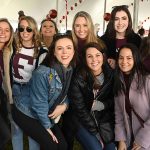


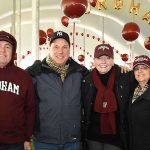


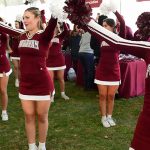


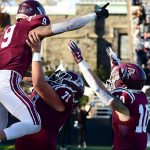
The temperature flirted with freezing, but nothing could extinguish the warm and joyous spirit at the Rose Hill campus on Saturday, Nov. 16, as Fordham hosted its annual Homecoming celebration.
The day began with 75 hardy souls taking part in the annual Ram Run, which sent runners on a 5K loop around the campus.
While they passed beneath the boughs of stately elm trees lining the campus, other revelers passed beneath the arches of Rose Hill’s Southern Boulevard entrance, heading to the parking lot where they set up for tailgate parties. The lot drew fans of both Fordham and the College of the Holy Cross, whose Crusaders ultimately won the Homecoming matchup 49 to 27.
Joe Jordan, GABELLI ’74, a Fordham Football Hall of Fame inductee who received the 2019 Mara Family Award, joined former teammate John Lumelleau, FCRH ’74 at the lot. Jordan was a freshman when football was reinstated as a Division I varsity program in 1970, after it was stopped in 1954 and revived as a club in the 1960s and then a Division III team in the NCAA.
“They brought back varsity on a shoestring, really,” said Lumelleau, who is also a member of the Fordham University Board of Trustees. Still, there was excitement on campus for the program, particularly a game their freshman year against Georgetown, soon after legendary coach Vince Lombardi, FCRH ’37, passed away.
“At halftime, they had the six surviving Seven Blocks of Granite,” Jordan recalled, citing the nickname given to Fordham’s fearsome linemen, including Lombardi. Wellington Mara “[current co-owner of the New York Giants]. was there, Marie Lombardi was there. There was no Lombardi Center—that’s when they dedicated it.”
The pair and many of their teammates still get together every year as a part of the “Rams of the ’70s” group that Lumelleau, a 2015 Walsh Family Award winner, helped start.
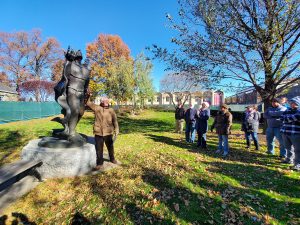
Reuniting Under the Big Tent
In the center of campus, beside the field where the Holy Cross Crusaders would face off with the Fordham Rams for the 57th time, several thousand alumni, students, families, and friends flocked to massive tents on Edwards Parade for burgers, pulled chicken, and libations. Several tables offered information about various alumni affinity groups, while the Fordham University Alumni Association (FUAA) collected four boxes of goods that attendees donated for POTS, a nonprofit that helps individuals facing poverty in the Bronx.
Outside the tent, Giant Jenga games lured guests on the west side of the parade, while face painting, a bouncy castle, wall climbing, and corn hole enticed families by the steps of Keating Hall.
Elsewhere on campus, members of the Mimes and Mummers Alumni Association celebrated their annual “Collins-coming” at Collins Auditorium, and former Fordham Law School Assistant Dean Robert J. Reilly, FCRH ’72, LAW ’75, guided a group of 30 on a walking tour of the campus titled Hidden in Plain Sight: Discover the Jesuit Presence at Rose Hill. Among the tidbits he shared was the fact that the statue of St. Ignatius of Loyola next to Hughes Hall was commissioned by Joseph M. McShane, S.J., president of Fordham, who requested that the founder of the Jesuits be depicted facing directly up at the heavens.
“If you Google St. Ignatius of Loyola, you will not find that except for one place. This is a very, very unusual statue,” he said.
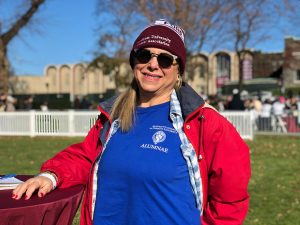
A Welcoming Community
Seated at one of the blue tables in the tent reserved for Marymount College alumnae was Teresita Abay-Krueger, MC ’80, who studied biology and chemistry and went on to work at IBM. For several years, she served on the Marymount alumnae board.
“Fordham has been a very welcoming community to the Marymount alumnae … You’ve really been cheerleaders for [our] legacy in many respects. And we not only appreciate it, but we respect that,” she said.
“It’s just been a natural melding of the two communities. And what better place to have it than Homecoming, where we get to celebrate a nice football game on a beautiful campus with plenty to eat and drink?”
A Bond Among Jesuit Schools
The event also drew families for whom loyalties between the Rams and the Crusaders were split. Bob and Rose Shea, natives of West Hartford, Connecticut, who graduated from the College of Holy Cross in 1985 and 1986, respectively, were sporting dark purple garb, while their daughter Fiona Shea, FCRH ’19, wore a hat that said simply, “Bronx.” Rose said they love the camaraderie between alumni of Jesuit schools. She’s also confessed to being obsessed with New York Botanical Garden, and noted that they became members during Fiona’s freshman year. Arthur Avenue is a must-stop for them every time they visit.
“Being from Connecticut, we’re more familiar with Boston, and of course we’re familiar with New York, but having Fiona here, it opened a whole new world to us,” she said.
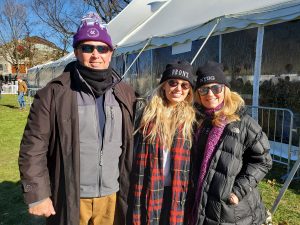
A Time for Families
Multiple generations of Rams took part in the day’s festivities. Lynn and Ryan Flaherty, both FCRH ’00, watched their children Nolan, 9, Reagan, 7, and Ainsley, 5, take their turns on the bouncy castles; they said there was never a question that they’d make the drive from Amityville, New York, for the day.
“We love bringing the kids here, and showing them where mom and dad went to school,” said Lynn. “They really do try to do something for the kids. Ryan’s parents join us, so we make it a big family thing.”
Jerry Breslin, FCRH ’59, likewise said he treasured the memories of his time on campus. He started returning after his son, John, graduated from Fordham College at Rose Hill in 1991. When he was an undergraduate, he said, he befriended the priest who was then the dean of men, and the priest officiated at Breslin’s wedding. Most of his former classmates had good friends who were Jesuits, he said.
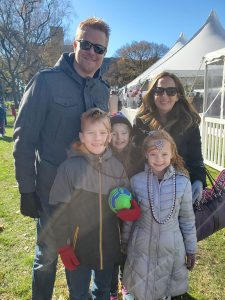
“In the springtime, after dinner we’d come out and play softball. There’d be a hundred Jesuits standing around, watching the game. You’d make an error or something, and they’d yell, ‘Breslin, you’re just as bad at softball as you are in the classroom,’” he said, laughing.
Chris Healy, on the other hand, never graduated from Fordham, but nonetheless feels at home at Rose Hill. He’s been coming here since he was seven, when his father, Richard Healy, FCRH ’50 and uncle, Stan Bloomer, FCRH, ’50, brought him to his first homecoming.
“My family has such a history here,” said Healy, wearing a Fordham jacket more than three decades old. “To me, it’s tradition and history that embellishes this University.”
His daughter, Brittany Healy, GABELLI ’17, was celebrating in the main tent, too. Growing up, she and her two older brothers frequently watched football games at the Rose Hill campus. Years later, she majored in business administration and marketing at Fordham—just like her grandfather.
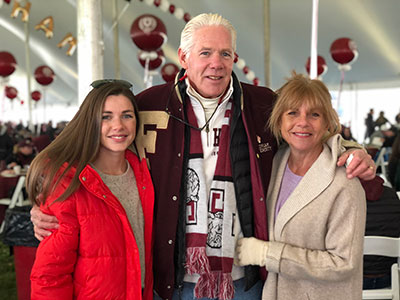
“My friends and I always talk about how Fordham is really like no other place on the planet,” said Healy, who is now an account executive at a public relations agency. “The community feel and the love that we have at this college is just different than anywhere else.”
For self-proclaimed “Fordham fanatic” Maggie Wimmer, FCRH ’16, this year’s homecoming had extra resonance.
“I love coming to homecoming. Whenever I get the chance to come back, I really enjoy it. And now that he’s in the program, it’s even more of a reason,” she said, motioning to her boyfriend, Matthew Glaser, a Ph.D. student in philosophy at Fordham.
“I haven’t even been to my undergraduate homecoming before, so this is a new experience for me,” said Glaser, who lives near Arthur Avenue.
Wimmer said she loves running into people she knew at Fordham, even if they were just acquaintances at the time.
“When you see them, it’s so exciting to relive those memories. It’s like you all have something to come back to,” said Wimmer, who majored in psychology at Fordham and now works in public health outreach at Hospital for Special Surgery in Manhattan.
“When we were graduating and Father McShane said, ‘This is your home, stay long and visit often’—you just connect with that, because when you walk on campus, it feels like home, like a breath of fresh air.”
View more photos from Homecoming.
Taylor Ha, Kelly Kultys, and Nicole LaRosa contributed reporting.
]]>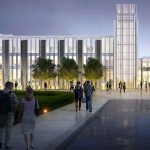
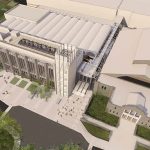

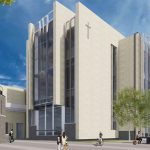
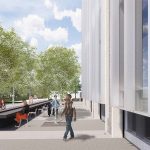
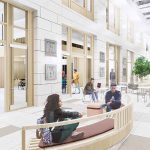
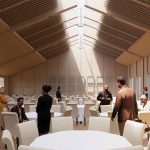
As Fordham celebrates the successful conclusion of Faith & Hope | The Campaign for Financial Aid, the University is transitioning to a new campaign dedicated to enhancing the overall student experience.
The centerpiece of the campaign will be a new campus center at Rose Hill that is scheduled to be completed in 2025. The campaign will also seek support for other student-focused issues like wellness, financial aid, athletics, and STEM facilities, which are being developed in the University’s strategic planning process.
“The new campus center will be bigger, both literally and in concept, than its current incarnation,” said Joseph M. McShane, S.J., president of Fordham. “It will be at the heart of the student experience campaign, and the student experience is at the heart of the University. In caring for the whole person, we want Fordham to be a place where students can live, learn, study, celebrate, dine, play, and perhaps most of all connect—with their peers and with the faculty and campus community.”
The campus center project, which the University began work on over the summer, will take place in two phases and cost an estimated $205.3 million.

A Dramatic Expansion
The first phase is scheduled for completion in August 2021 and will entail the construction of a roughly 75,000-square-foot addition in the area in front of the existing McGinley Center.
The sleek glass and stone addition will be connected to the existing structure via a two-story glass arcade, with elevated walkways between the two buildings. The glass canopy-topped main entrance will beckon visitors into an airy space between the Rose Hill Gym and the new addition. The center’s façade, once defined by the modernist arches of the McGinley building, will now be dominated by vertical, soaring windows and stonework that complement the neighboring Gym. In a nod to iconic Rose Hill structures such as Keating Hall and Duane Library, it will also feature a four-story illuminated tower immediately to the west of the entrance.
Once the addition is complete phase two will begin, and the existing structure, which was built in 1958, will be gutted and renovated. When it is finished, it will feature 22,000 square feet of dining facilities and 36,000 square feet of state-of-the-art sports and fitness facilities. Ultimately, the new campus center, which is being designed by the architecture firm HLW, will be much larger, encompassing more than double the space of the original building. It will also include efficient LED lighting, heat recovery systems, enhanced insulation, solar panels, and other features designed to lower its carbon footprint.
The expansion will allow for a dramatic increase in space for several areas. The 20,000 square-foot fitness center will encompass more than half of the basement level, while more than 16,000 additional square feet will be devoted to sports medicine and a varsity weights training center. A 9,500-square-foot student lounge will occupy the first floor of the addition, while Career Services, the Center for Community Engaged Learning, and Campus Ministry will be housed in larger offices on the second floor. The third floor of the addition, which will rise a floor above the existing McGinley Center, will feature space for meetings and special events.
Funding for the Center
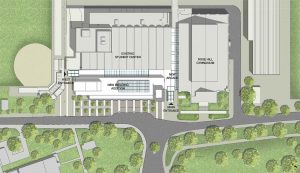
Funding will come from a combination of fundraising, loans, and dining services provider Aramark, which has committed $13.3 million toward the renovation of the dining facilities. Fordham will borrow $150 million through a bond offering, and raise up to $85 million for the project through the next capital campaign.
Together, nine donors have already committed $10 million toward the Campus center. Maurice J. “Mo” Cunniffe, FCRH ’54 and Carolyn Dursi Cunniffe, Ph.D., UGE ’62, GSAS ’65, ’71, whose generosity in the previous campaign led to the creation of the Maurice and Carolyn Cunniffe Presidential Scholars Program, has given $3 million.
Other donors include Board of Trustees Chair Robert (Bob) Daleo, GABELLI ’72, and Linda Daleo; Trustee Fellow Emerita Kim Bepler; Trustee Emeritus Robert E. Campbell, GABELLI ’55, and Joan Campbell; former Trustee Stephen J. McGuinness, GABELLI ’82, ’91, and Anne McGuinness; Trustee Brian MacLean and Kathy MacLean, both FCRH ’75; Brian Kelly, LAW ’95; former New York City Mayor Michael R. Bloomberg; and several anonymous donors.
The center will feature many spaces with naming opportunities. Among the high-profile spaces in the new building are the fitness center, arcade, career services space, and special events space. When refurbished, the original building’s main dining room, ballroom, and student affairs suite will be available as well.
A Positive Financial Picture

The bulk of the funding for the project will come from a loan that the University will take on through a bond offering via the Dormitory Authority of the State of New York.
Martha K. Hirst, senior vice president, CFO, and treasurer, noted that Fordham is able to do this in part thanks to the University’s solid financial footing. Last month, for instance, global rating agency Standard & Poor upgraded its outlook on Fordham from negative, which it issued in 2017, to stable, and affirmed its “A” long-term rating on outstanding bonds. The University previously borrowed $212 million in 2008 via bonds for the construction of the new Law School building; Hirst said it continues to be the best way to finance big projects.
A Focus on Students
Jeff Gray, senior vice president for student affairs, said the new campus center will dramatically increase the ability of the University to deliver the services and spaces that students need to thrive.
“We have clearly outgrown the current campus center over the years, and it’s going to bring online a lot of exciting new spaces that will improve the quality of life for all our students,” he said.
He noted that in recent surveys of students at Rose Hill, 60% indicated that current student club and programming spaces are inadequate for their needs, which is not surprising given that the center was built to accommodate just 2,500 undergraduates total, 850 of whom lived on campus at the time. Today, 3,500 students live on campus, another 1,000 live in off-campus housing and another 2,000 commute to campus. The new campus center will be a place where all of these students can come together to socialize and collaborate.
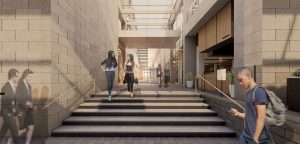
For a preview of the benefits to come, Gray pointed to the 2016 renovation of the garden level of the Lincoln Center campus’ 140 W. 62nd Street.
“There’s a retail dining facility there that’s very popular; there’s a large community lounge where students gather, study, and meet; there’s dedicated space for student clubs; and dedicated space for important student services, like the dean of students, student involvement, health services, counseling, and career services,” he said.
“They’re all located in that hub, and that’s had a very palpable, positive impact on the quality of life for our students at Lincoln Center. We hope to achieve some of the same benefits at Rose Hill on a larger scale.”
Studies have shown that the longer a student remains on campus and in an academic mindset, the greater their chances are for academic growth and success, Gray said, noting that student retention is a key priority for the University. The new campus center at Rose Hill, he said, will be designed to give students a better sense of place outside the classroom.
In addition to dining, fitness, student lounge, and career services spaces, Gray said he expects that students will benefit greatly from the improved office spaces for departments such as Campus Ministry, the Center for Community Engaged Learning, and the Office of Student Involvement, which supports student clubs and activities.
“Those services are certainly central to our mission and what we do, and I think all of those things have the net effect of improving the overall student experience for the students,” he said.
]]>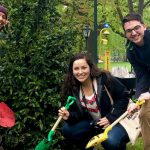
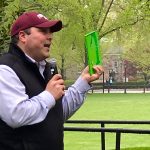
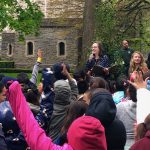 For the fourth year in a row, Fordham has achieved national recognition for its devotion toward Mother Nature.
For the fourth year in a row, Fordham has achieved national recognition for its devotion toward Mother Nature.
Since 2015, Fordham has participated in Tree Campus USA, a national program that honors colleges and universities for promoting tree conservation across their campuses. Participating institutions complete five tasks: creating a tree advisory committee, developing a campus tree-care plan, annually dedicating funds toward a campus tree program, celebrating Arbor Day, and sponsoring related student service-learning projects.
A week ago, the University celebrated Arbor Day with some special guests—nearly 120 second graders from P.S. 205. On April 30, the second graders, Fordham students, and University staff gathered at the Rose Hill campus for a giveaway, a poetry reading, and a series of speakers. Together, they planted a holly tree in a grassy patch bordered by Keating Hall, Spellman Hall, and John Mulcahy Hall.
The young tree joins the Arbor Day Foundation’s initiative of planting 100 million trees and engaging five million tree planters by 2022.
“This year, Tree Campus USA schools have collectively planted 32,204 trees and engaged 31,682 students—helping us work toward these critical goals and the large-scale impact we seek,” wrote Dan Lambe, the president of the Arbor Day Foundation, in a letter to Joseph M. McShane, S.J., president of Fordham. “And your continued dedication to trees will help to create lasting change for future generations.”
]]>“Why do I find myself representing the children of former clients?” he wondered. “When will all of this hurt end? Most importantly, where is God in all of this and why am I a witness to such horror?”
He started digging deeper into his motivations for becoming a public defender, and realized he was drawn to his clients’ plight. “I knew I cared for them and was always fighting for them,” he says, “but I didn’t realize just how deeply they had touched me.”
Booth recognized that there was a spiritual element to addressing the causes of criminality and the problems of mass incarceration and recidivism, and that there were limits to what he could do in his role as a lawyer, both from an ethical and a practical standpoint. He knew that it was inappropriate to discuss matters of faith with his clients, that “melding the roles of attorney and minister can add another injustice upon the accused person,” as he put it, but he also had no plans to give up his day job.
A Route to Spiritual Freedom
So in 2009, after considering ways to help people like his clients beyond the courtroom walls, and after the loss of a child to stillbirth, Booth started a journey toward deeper spiritual reflection and practice. He began further exploring Ignatian spirituality and took the Nineteenth Annotation, or the “Ignatian retreat in daily life,” a way to complete the Spiritual Exercises of St. Ignatius in a less intensive time period than the traditional 30-day retreat.
He also felt that the Spiritual Exercises could prove as valuable a healing process to incarcerated people as they were to him.
“I know there are many routes to that goal of freedom for everybody, and [Ignatian spirituality] is just one potential route,” Booth says. “Since it meant something to me, I thought it might be meaningful to others.”
That thinking led Booth to Fordham’s Graduate School of Religion and Religious Education (GRE), where he completed a master’s degree in religious education in 2014. His studies culminated in a thesis titled “Prison Ministry’s Quest for Spiritual Freedom in the Spiritual Exercises of St. Ignatius of Loyola,” which explored how the Exercises could be applied within a prison setting to provide emotional support and spiritual freedom to inmates, and to help them make a successful transition to society after release.
“You can still bring the spirituality [into prisons], and you bring portions of the Exercises,” Booth says. “They need that psychology. They need to be able to somehow express what they’re going through in a safe environment. A lot of [inmates]will say that they can’t do this on their own.”
Bringing Guidance Behind the Walls
Booth’s desire upon completing his master’s was to become a part-time prison minister outside of his professional jurisdiction and establish a prison ministry program in his and other parishes in Jersey City. As he continued to look into bringing those goals to fruition, he met Zach Presutti, S.J., a Jesuit scholastic and a psychotherapist with an interest in prison ministry. Booth gave Presutti a copy of his thesis, and Presutti realized it was the exact kind of spiritual guidance he wanted his new nonprofit, Thrive for Life, to provide for the incarcerated.
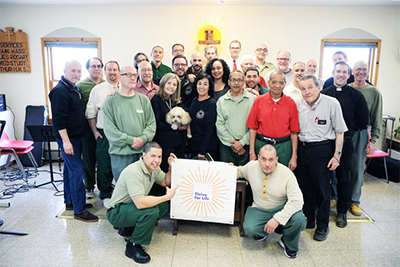
Booth drew on his thesis to create a brochure for Thrive for Life, “From Fear to Freedom: Spiritual Exercises Behind Prison Walls,” which functions as a guide for those providing Ignatian spiritual direction to inmates. Meanwhile, he began volunteering with Thrive for Life as a spiritual director within the prison setting.
Now, several times a month, Booth visits with inmates in New York—at Sing Sing Correctional Facility in Ossining, the State Correctional Institution in Otisville, and the Manhattan Detention Complex, also known as the Tombs—leading them through an abridged version of the Spiritual Exercises. He has become one of the core volunteer spiritual directors with Thrive for Life.
“[When we met], it was clear to me that this man was a disciple of Jesus,” Presutti says of Booth. “I saw someone who could really accompany the men behind the walls in their spiritual life.”
Booth relishes seeing inmates open up as they transition to life outside the prison walls.
“They can just kind of let go and be themselves and express themselves,” he says. “And as time goes on, you see them expressing more and more and more, individually, and collectively.”
Breaking the Cycle, Building Relationships
The relationships between Thrive for Life’s spiritual directors and the inmates with whom they work does not end once the inmates are released from prison. One former inmate now works full-time at Thrive for Life. Many others gather once a month for a Sunday dinner at the Church of St. Francis Xavier, where the organization is based. These dinners not only include volunteers and former inmates but also family members and partners. Thrive for Life recently opened Ignacio House, a Bronx residence with space for 20 to 24 men who have recently been released from incarceration.
Booth himself is working to expand his thesis into a book-length text that would serve as a manual for the organization, and he recently contributed an essay on the stressors of racism in inmates’ lives to Today I Gave Myself Permission to Dream: Race and Incarceration in America, published by the University of San Francisco Press. He also provides one-on-one spiritual direction for parishioners at St. Francis Xavier through Charis NYC, and for two inmates on death row at San Quentin State Prison in California, corresponding with them by letter.
Meanwhile, his workload as a public defender, was made more manageable by the bail reform measures New Jersey instituted two years ago, eliminating cash bail and setting new standards on releasing individuals based on whether they pose a danger to society. He is now able to focus on processing cases and appearing for a smaller number of trial cases. Beyond that, his volunteer work as a spiritual director has given him new perspective on his day job, and he says his colleagues have reacted very positively when they find out about his life as a spiritual guide.
Booth credits his wife, Nancy Mendez-Booth, with being at the center of everything he does, but he says it was his time at Fordham’s Graduate School of Religion and Religious Education that laid the foundation for his current work and provided the opportunity to explore how to practice his faith in service of others.
“Courses were geared toward trying to live out your faith in the modern world with constant interaction with the real world,” Booth says.
“Fordham made me into the best spiritual director that I could be.”
]]>As part of a continuing commitment to reduce its carbon footprint, Fordham has increased its sustainable energy sources with the use of on- and off-campus solar arrays.
A 963-kilowatt solar panel array was recently installed atop the five-story parking garage on Fordham’s Rose Hill campus and is expected to be operational in April, thus dramatically increasing the University’s embrace of renewable energy.
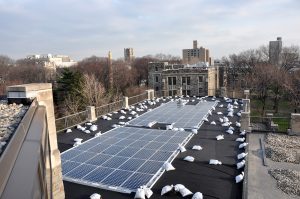
The array, which comprises 2,790 individual solar panels, is the second to be installed at Rose Hill and will generate electricity for use throughout the campus. In 2010, 84 panels were installed on the roof of William D. Walsh Family Library; they generate 25 kilowatts for the library, Rose Hill’s most energy-intensive building.
The University has also begun drawing renewable energy from off-site sources, including the largest solar-power system in New York City to date. In July, Fordham signed a 20-year agreement with the solar developer EnterSolar to purchase electricity generated at a 10-acre, 9,000 solar panel installation just east of the Arthur Kill waterway in Staten Island. It will generate up to 2.6 megawatts of solar power annually, which will be credited to Fordham’s energy usage.
A Greener Source of Energy

Marco A. Valera, vice president of facilities management and sustainability at Fordham, said that the new power sources can provide over 20 percent of the total electric consumption at the university when operating at maximum production. It makes Fordham the largest consumer of locally installed solar capacity of any college in New York City and goes a long way toward cutting the University’s carbon output.
In 2007, Fordham accepted the New York City Carbon Challenge and committed to reducing its greenhouse gas emissions by 30 percent. In the fall of 2017, the University extended its commitment to the challenge by pledging a 40 percent reduction by 2030.
In addition to cutting back on carbon emissions, the combined off- and on-site arrays will result in approximately $200,000 annual savings for Fordham for 20 years.
“This is a terrific initiative for the University, as we achieve budget savings over the term of the 20-year contract at the same time that we significantly reduce our greenhouse gas emission profile,” he said.
“Sustainability ties into Jesuit beliefs and practices. It’s good for the environment, and in this case, it is good for us financially. It’s a win-win.”
Julie Milea, FCRH ’17, EnterSolar’s engineer for the Rose Hill project, added that solar power is not only cost-effective but an efficient use of green or renewable power. It draws the most power during peak daylight hours, exactly when there is the most electric use in buildings.
Valera said that the cost of solar panels has recently become more economically feasible, but that tax breaks and grants from federal and state governments on renewable energy sources still play a big role in making them affordable, especially in northern parts of the country where solar hours are limited.
The University is also pursuing other sites for additional solar arrays, including a 8-kilowatt array that will be installed on the roof of Campbell Hall later this year and partly funded by Fordham graduates.
[doptg id=”141″] ]]>